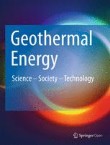Associated Societies
Investigation on geothermal binary-flashing cycle employing zeotropic mixtures as working fluids
The binary-flashing cycle (BFC) is supposed to be a promising technology for geothermal recovery due to the full use of geofluid. For further performance improvement, the potential of using mixtures of a hydro...
